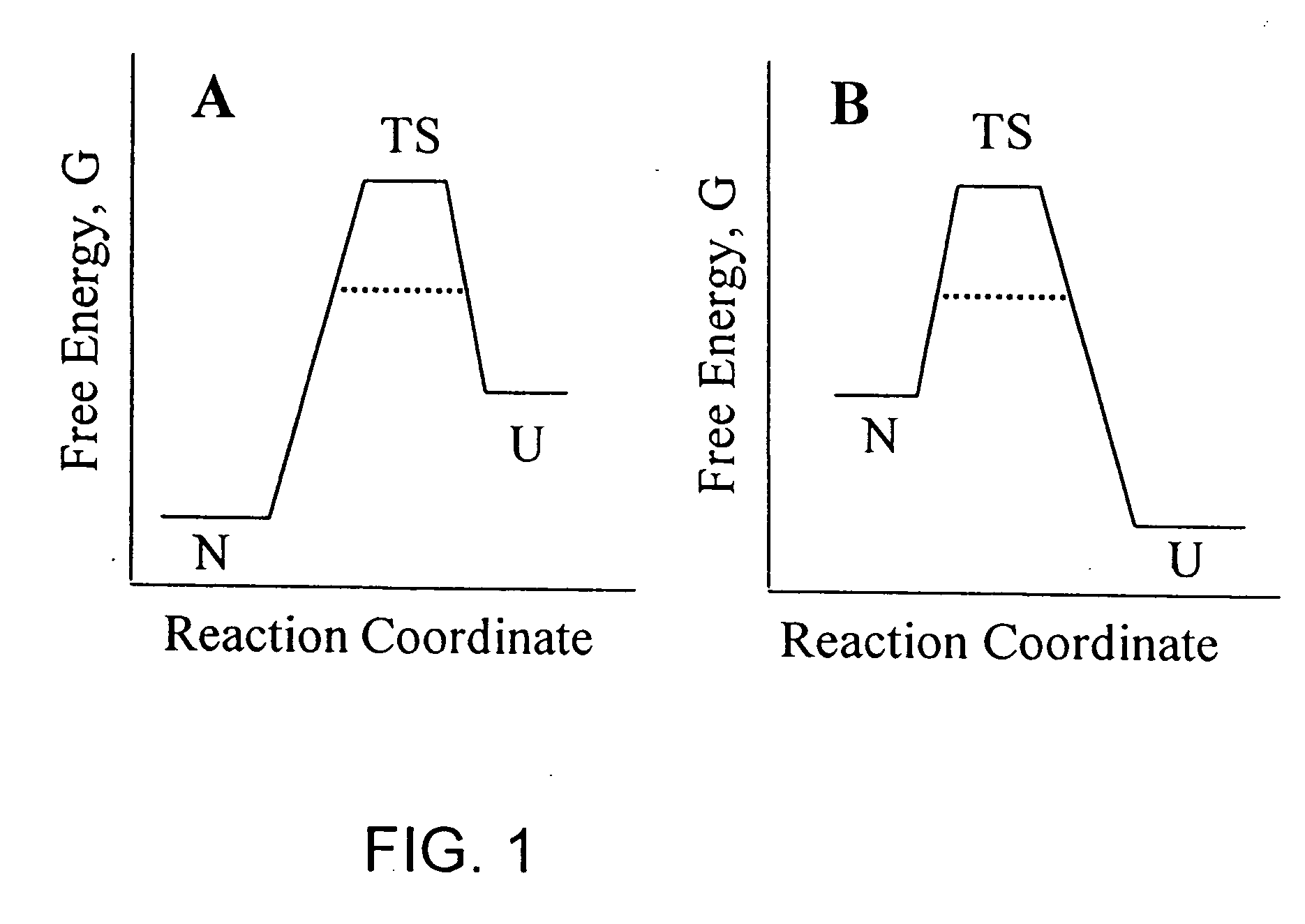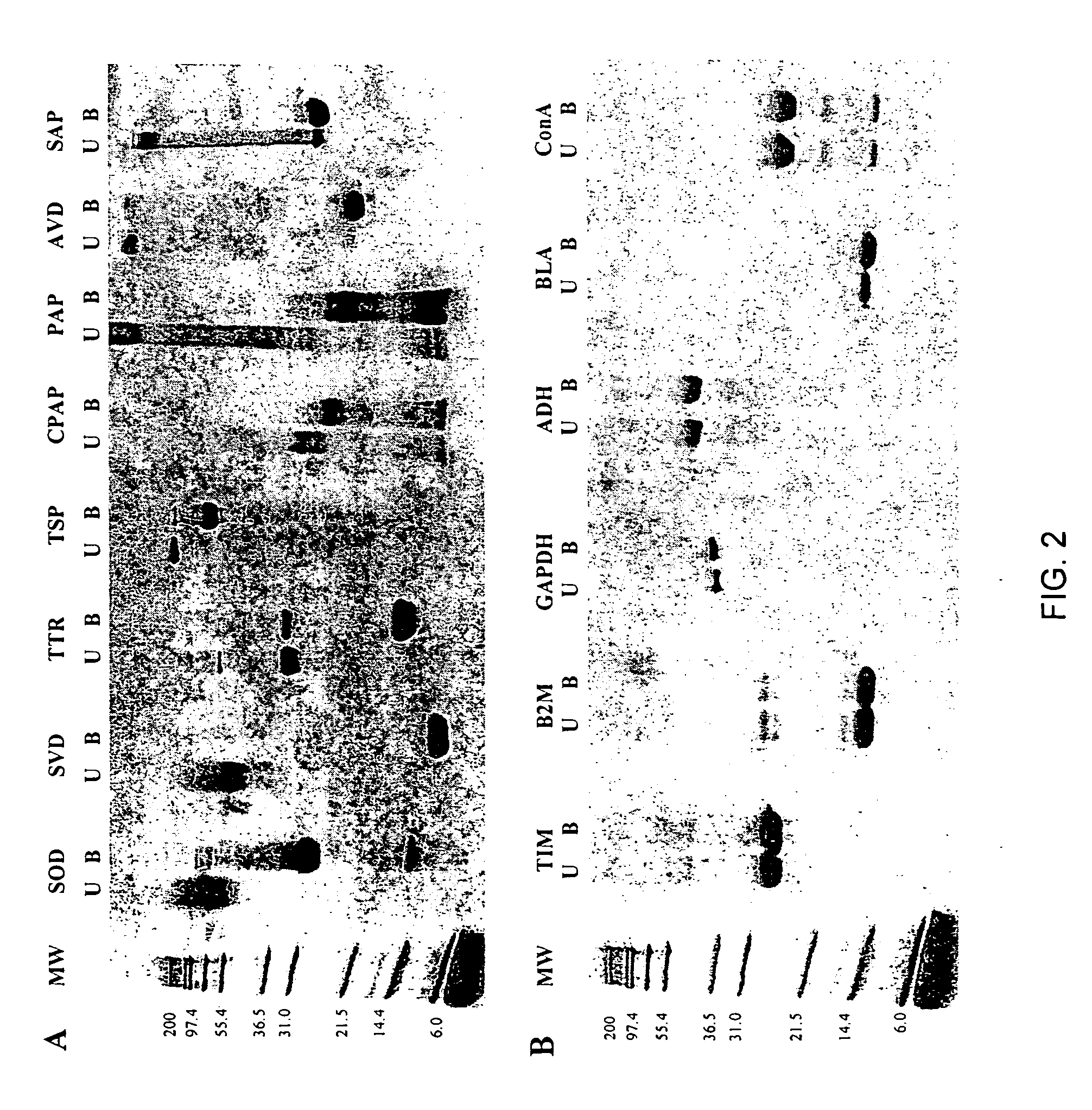Methods of identifying kinetically stable proteins
a kinetic stability and protein technology, applied in the direction of fluid pressure measurement, liquid/fluent solid measurement, peptide measurement, etc., can solve the problems of incomplete protein protection, no structural consensus, and poorly understood physical basis of kinetic stability, so as to achieve fast and efficient means, fast and efficient results, and slow unfolding rate
- Summary
- Abstract
- Description
- Claims
- Application Information
AI Technical Summary
Benefits of technology
Problems solved by technology
Method used
Image
Examples
example 1
SDS-polyacrylamide Gel Eectrophoresis (SDS-PAGE) Assay. Lyophilized proteins were obtained from Sigma (papain (PAP), chymopapain (CPAP), avidin (AVD), and superoxide dismutase (SOD)) and Calbiochem (streptavidin (SVD), serum amyloid P (SAP), and transthyretin (TTR)). Salmonella phage P22 tailspike (TSP) protein was a gift from J. King (MIT). All the remaining proteins (Table 2) were obtained from Sigma with the exception of catalase, which was purchased from Calbiochem. Stock solutions (1 mg / mL) of all proteins studied except papain, chymopapain, and P22 tailspike protein were made using 10 mM sodium phosphate buffer (pH 7.0) (PB). Stock solutions (1 mg / mL) of papain and chymopapain were prepared with 25 mM 2-amino-2-hydroxymethyl-1,3-propanediol (Tris), 1 mM EDTA (pH 5.3). The stock solution of the P22 tailspike protein was 0.8 mg / mL in 50 mM Tris, 2 mM EDTA (pH 7.6). All electrophoresis samples contained ˜5 μg protein and 1% sodium dodecyl sulfate (SDS) in 0.125 M Tris (pH 6.8). ...
example 2
Proteolysis. For limited proteolysis experiments the concentration of the proteins was determined by weighing the lyophilized protein on a microbalance. Each proteolysis reaction mixture contained about 0.5 mg / mL protein and 5 μg / mL proteinase K (Fisher Scientific) in 25 mM Tris, 1μM EDTA (pH 8.3), and was incubated at 25° C. for 48 hours. The reaction was stopped with a solution of 2.5 μM phenylmethylsulfonyl fluoride, 4% SDS in 0.125 M Tris, 3.4 μM 1,4-Dithio-DL-threitol (pH 6.8)). Samples were boiled and gel electrophoresis was performed using 16% acrylamide Novex precast gels (Invitrogen). Running buffer was 0.1% SDS in Tris / Tricine buffer (pH 8.1).
example 3
Fluorescence. Unfolding kinetics induced by guanidine hydrochloride (GdnHCl) were monitored using an F-4500 fluorescence spectrophotometer (Hitachi, Danbury, Conn.). The concentration of GdnHCl was determined using an Abbe Mark II refractometer (Leica, Buffalo, N.Y.). Protein solutions (0.05 mg / mL) in 25 mM PB, 0.20 M sodium chloride (pH 7.2) were treated with GdnHCl solution made using the same buffer to a final concentration of 6.6 M. The excitation / emission wavelengths used were: 275 / 350 nm (B2M), 275 / 360 nm (BLA, ConA, GAPDH, TIM), 280 / 320 nm (ADH), 295 / 360 nm (CPAP, TTR), 295 / 350 nm (PAP), 295 / 340 nm (SAP, TSP), 280 / 330 nm (SOD), 295 / 333 nm (SVD), and 280 / 340 nm (AVD). Kinetic traces were analyzed by fitting to a sum of exponentials.
PUM
| Property | Measurement | Unit |
|---|---|---|
| Electrical resistance | aaaaa | aaaaa |
| Stability | aaaaa | aaaaa |
| Kinetic theory | aaaaa | aaaaa |
Abstract
Description
Claims
Application Information
 Login to View More
Login to View More - R&D
- Intellectual Property
- Life Sciences
- Materials
- Tech Scout
- Unparalleled Data Quality
- Higher Quality Content
- 60% Fewer Hallucinations
Browse by: Latest US Patents, China's latest patents, Technical Efficacy Thesaurus, Application Domain, Technology Topic, Popular Technical Reports.
© 2025 PatSnap. All rights reserved.Legal|Privacy policy|Modern Slavery Act Transparency Statement|Sitemap|About US| Contact US: help@patsnap.com



